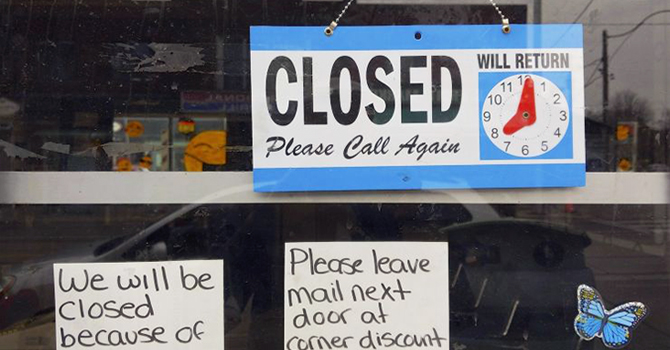Recessions Often Improve Population Health, but COVID-19 May Be Different

Sarah Burgard and Lucie Kalousova

As the economic devastation of the COVID-19 pandemic is becoming painfully evident—already some seventeen million workers have filed for unemployment benefits in the United States—questions are arising about how the emerging recession will further impact population health. Though many as-yet-unanswerable questions remain, we are likely to see a mix of negative and positive health consequences.
Click Here for the Latest on COVID-19 from Michigan Public Health ExpertsThanks to a revival of research and debate in the wake of the Great Recession, we know that recessions lead to short-term improvement in life expectancy at the population level, but also to declining well-being for those individuals who experience labor market, housing, and asset shocks. However, never in living memory have we faced this one-two punch of a massive health crisis triggering an economic one. Predictions based on past experience must tread cautiously if we are to make the best use of existing scholarship and policy strategies to mitigate the population health consequences of the coming recession.
Though it may seem counterintuitive, evidence from around the world has shown that the mortality rate falls relatively quickly in recessions, and consequently that life expectancy rises.
We should start with what we know from past economic downturns. Though it may seem counterintuitive, evidence from around the world has shown that the mortality rate falls relatively quickly in recessions, and consequently that life expectancy rises. Most evidence has come from milder downturns, but the same pattern was also found for the Great Depression in the United States. What explains this “silver lining” of past recessions for population health? With the deceleration in business and industrial activity, commuting and air pollution fall, leading to a drop in traffic-related fatalities and cardiovascular deaths. There is already evidence that the pollution burden in cities like Los Angeles has been radically reduced in the wake of stay-at-home orders and the shutdown of many businesses and social activities.
Beyond the environmental changes that provide broad reductions in health risk, other ways we respond to recessions could lead to improvements or reductions in population health. Some scholars have argued that the time regained when people face work slowdowns or unemployment allows for more leisure, physical activity, home cooking, and other behaviors that could enhance well-being. A shock to disposable income could also reduce consumption of tobacco or alcohol. Counterbalancing these positive effects are the stress and uncertainty of financial strain and psychological distress, which may lead to less than optimal use of new free time (such as sedentary television viewing), may reduce work-related physical and social activities, and could also increase negative coping with tobacco or alcohol, particularly for those who already use them regularly.
The most consistent negative population health consequence of recessions is a rise in suicide mortality. Such a pattern is devastating but not surprising, given the stress and material hardships associated with the kinds of events that increase during economic downturns, including job losses, long-term unemployment, and loss of financial and housing assets. Stress has also been implicated in reduced mental well-being and increases in inflammation and reduction in immunity, all factors that threaten mental and physical health.
While there is considerable research to draw on as we speculate about the health impacts of the COVID-19 recession, the situation we face now makes it risky to rely only on past experiences. Consider three of the most obvious differences that distinguish the COVID-19 era.
First, this recession is being triggered by a global viral pandemic that threatens many of the usual “silver linings” of economic downturn. Stay-at-home orders and closures of nonessential businesses keep us from many of the activities we might have more healthfully traded for paid work or commuting, such as going to the gym, spending time outdoors, or socializing with friends. Lockdown also means that in-person social and instrumental support we typically provide or receive from others may be curtailed, increasing isolation and making health maintenance—physical as well as mental—more challenging. It may also be difficult to devote more time to healthful behaviors such as adequate sleep in homes overcrowded by shelter-mates, or to cooking healthy meals if groceries are difficult to get. And parents across the country who are still employed are struggling to manage both their paid jobs and the very challenging work of caring for and educating their children.
Several factors suggest that the normally health-enhancing aspects of recessions may be weaker and overall population health impact more negative.
Second, the health care sector has been decimated by COVID-19, with facilities overwhelmed, essential supplies limited, and health care providers strained beyond normal limits. Tragically, some health care providers have been sickened or even killed by the virus, and those still on the front lines are desperate for more support and safe conditions. These circumstances will leave our health care system frail even after the first wave of the virus has abated, precisely when a wave of delayed procedures are treatments are being sought. Our ability to increase health care system capacity will be important in the fight against future waves of viral outbreak, but budgets may not accommodate expansions. The capacity of preventive public health systems will also be constrained in the coming months, and a great deal of scientific activity will be diverted to attempts to control the virus—leaving fewer resources for other important public health functions. Beyond the budgetary strain, another tragic consequence of COVID-19 is the cessation of mass vaccination against preventable diseases such as polio and measles, given the risk of viral transmission in such face-to-face efforts. Exhausted and financially strapped health care and public health systems will make it even harder to maintain the population’s health as the economy falters and recovery attempts are made.
Third, sudden changes in what makes a job dangerous could stymie traditional paths to economic recovery, and they are revealing and exacerbating deep social inequalities. More advantaged Americans are likelier to have the option to work from home, the resources to adapt to new and rapidly changing expectations, and the assets to weather what is likely to be a long storm. By contrast, COVID-19 has dealt devastating blows to a low-wage workforce already facing health disadvantages, and communities of color are bearing a disproportionate number of fatalities. If low-wage workers are sickened because they cannot afford not to work in a pandemic, or because they do not have the ability to safely self-quarantine, who will staff the massive share of low-wage service jobs when the economic engines start up again? One of the “silver linings” of past recessions was a decline in workplace accidents, presumably because the most experienced or qualified workers kept their jobs and a slower pace of production allowed for more attention to worker safety. A cruelty of this highly transmissible viral pandemic is that simply being at the workplace can pose health risks, and while attention to traditional workplace hazards is not likely on the radar.
Given these differences, where are we likely headed in these unprecedented times? Several factors suggest that the normally health-enhancing aspects of recessions may be weaker and overall population health impact more negative. Even before this economic downturn, US data suggested a weakening of the traditional recession-induced life expectancy bump. One proposed explanation for that weakening has been the increasing role of cancer in driving overall mortality rates. In the past, cancer deaths were only weakly related to the business cycle, but that relationship may be strengthening as the affordability of new and effective cancer treatments declines in tough economic times. It is too early to tell how drastically the pandemic will shape the cause of death profile in the coming months and years, and how much this will influence the historically consistent association between personal economic resources and health. Further examination of emerging overall and cause-specific mortality patterns, and of the mechanisms that underlie them, will be critical to understand whether COVID-19 will change the nature of the link between recessions and life expectancy in the United States.
Another factor working against a population health silver lining is that older Americans are at greater risk of mortality. Even if they do not contract the virus, those who face other health problems typical of later life are at greater than normal risk because the surge of attention and resources toward COVID-19 may delay necessary care and lessen survival associated with other causes. Health among survivors may also be compromised by the challenges of sheltering in place, from an increased risk of domestic violence to the harmful effects of spending long periods of time exposed to environmental hazards for those living in poorly maintained and crowded housing. Some of these hazards are unequally felt by poor Americans, potentially widening existing disparities by income, race, ethnicity, gender, and other social characteristics.
Stay-at-home orders and closures of nonessential businesses keep us from many of the activities we might have more healthfully traded for paid work or commuting.
The health impacts of the COVID-19 downturn will also depend on the precise nature of the economic recovery—how quickly and effectively the record-shattering unemployment claims of the past few weeks are reversed. Policies to maintain workers on payrolls even during a slowdown or to support businesses that will be able to rehire them can lessen the damaging social, economic, and health consequences of long-term unemployment, though the need for social distancing and the resulting devastation of many industries make this much more challenging. Individually directed stimulus funds will be a welcome relief to cash-strapped Americans, but it is less likely they will stimulate the economy as they would in a typical recession.
This is to say nothing of the health effects outside of the United States. We know very little about how economic recessions are linked to population health developing countries; most research has been conducted in wealthy ones. However, there is cause for concern. While there is evidence already that air pollution is falling sharply in cities across the globe, residents of many urban metropolises face much greater challenges in adequately physically distancing due to residential crowding and poorer quality housing stock, potentially stretching out the duration of the epidemic and associated recession.
Additionally, the severe short-run lack of personal protective equipment and intensive care unit beds to deal with surges of patients will add to the toll of mortality. In the longer run, many poorer nations have even fewer financial resources to backstop overloaded health care systems and to provide social safety nets during economic downturns. Many countries will also suffer from declining revenues from tourism, dwindling remittances from household members working abroad, and challenges with systems of migratory labor that have supported economic well-being in many communities.
This unprecedented set of circumstances provides an opportunity to innovate in ways that will support population health as we face future crises.
How can we best prepare for the downturn’s health effects? We should certainly pursue extensions to social welfare programs including food stamps and unemployment insurance: these are powerful tools that reduced material hardship in the Great Recession and that can help even under shutdown conditions. Protecting jobs and protecting households from health-harming food insecurity and financial strain are a start, and rent and mortgage freezes, extended moratoria on evictions, and forgiveness or extended grace periods on all forms of student loans are other ways to ease the financial strain facing so many Americans. However, we must also think beyond short-term, stopgap measures. The COVID-19 pandemic reveals deep fault lines in our economic norms, social safety net, and public health infrastructure and lays bare persistent health disparities across social groups.
This unprecedented set of circumstances provides an opportunity to innovate in ways that will support population health as we face future waves of COVID-19 and other social, environmental, and health crises. One line of reform should involve better social policies. Distribution of social welfare assistance through cash transfers, food stamps, unemployment assistance, and housing assistance could be bolstered and simplified in ways that help poorer families handle more typical shocks to employment or health. We must also consider the human and economic costs of lacking adequate health insurance, as this pandemic has revealed the risks to the entire population of uninsured individuals avoiding testing for COVID-19 for fear of an unaffordable bill or failing to access appropriate care when experiencing symptoms. We could also take advantage of more widespread recognition of the value of paid sick leave, a benefit that so many Americans lack but one that could greatly enhance individuals’ ability to stay home and heal, or care for loved ones who are ill.
Finally, we must also work to tackle systemic issues underlying inequitable health outcomes. Reports have shown COVID-19 to have a disproportionately large mortality rate among black Americans, for whom generations of structural racism have left their communities more vulnerable to the chronic health conditions that make COVID-19 particularly deadly. Addressing these and other longstanding health disparities, as well as our social welfare and public health systems, could make Americans more resilient to the population health challenges we already face and the new ones that will arise.
About the Authors
 Sarah A. Burgard is professor of Epidemiology, associate professor of Sociology, and research associate
professor in the Population Studies Center at the University of Michigan. Her work
focuses on the way systems of stratification and inequality impact the health of people
and populations. Her current research focuses on the variety of conditions that characterize
“bad jobs” and how these influence health over the career. Recent work has examined
the impact of perceived job insecurity and actual involuntary job loss on a variety
of health outcomes among US adults. Other ongoing projects include work on racial/ethnic,
gender, and socioeconomic differences in infant and child health in South Africa,
and Brazil, and China.
Sarah A. Burgard is professor of Epidemiology, associate professor of Sociology, and research associate
professor in the Population Studies Center at the University of Michigan. Her work
focuses on the way systems of stratification and inequality impact the health of people
and populations. Her current research focuses on the variety of conditions that characterize
“bad jobs” and how these influence health over the career. Recent work has examined
the impact of perceived job insecurity and actual involuntary job loss on a variety
of health outcomes among US adults. Other ongoing projects include work on racial/ethnic,
gender, and socioeconomic differences in infant and child health in South Africa,
and Brazil, and China.
 Lucie Kalousova, MA ’17, PhD ’17, is assistant professor of sociology at the University of California,
Riverside. She received her PhD in Sociology and Health Services Organization and
Policy from the University of Michigan. Before moving to California, she was a Postdoctoral
Prize Fellow in Sociology at Nuffield College, Oxford in the United Kingdom. She recently
was honored with a Neuron Prize, an award presented annually to six promising Czech
scientists to boost the visibility of Czech science and reward early career success.
Her research is motivated by the sociological project to advance our understanding
of the links between the distribution of socioeconomic resources and health of populations.
Lucie Kalousova, MA ’17, PhD ’17, is assistant professor of sociology at the University of California,
Riverside. She received her PhD in Sociology and Health Services Organization and
Policy from the University of Michigan. Before moving to California, she was a Postdoctoral
Prize Fellow in Sociology at Nuffield College, Oxford in the United Kingdom. She recently
was honored with a Neuron Prize, an award presented annually to six promising Czech
scientists to boost the visibility of Czech science and reward early career success.
Her research is motivated by the sociological project to advance our understanding
of the links between the distribution of socioeconomic resources and health of populations.
- Interested in public health? Learn more today.
- Learn more about Lucie Kalousova’s path to public health in Tobacco Control: A Success Story with a Side Story.
- Read more articles by Health Management and Policy and Epidemiology alums, faculty, and students.
- Support research at Michigan Public Health.
